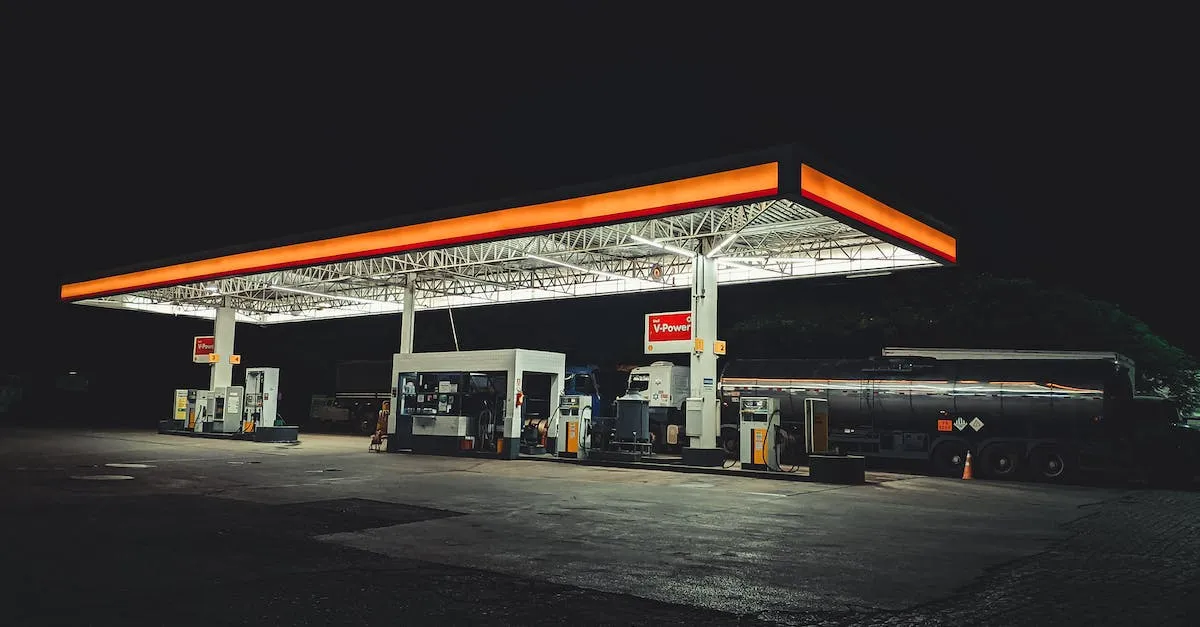Fueling Up In The City That Never Sleeps: A Deep Dive Into New York City Gas Stations
New York City is known for its iconic yellow taxis, crowded subways and constant bustle. But with over 1 million private vehicles on the road, gas stations remain a critical piece of the city’s infrastructure. For anyone unfamiliar with the area, questions arise: What is it like to fill up in NYC? How many stations are there? And what accounts for the high prices?
If you only have a minute, here’s a quick rundown: New York City has around 550 active gas stations, the majority being independent businesses rather than major brands. Stations are small and packed densely across the boroughs. And NYC gas prices are among the highest in the U.S., due to real estate costs, regulations and taxes.
In this roughly 3000 word guide, we’ll provide an in-depth look at gas stations throughout New York City. We’ll explore their history, regional variations, operations, the factors behind the high prices and what the future may hold as alternate fuels gain traction.
The History and Decline of NYC Gas Stations
New York City, the bustling metropolis known as the “City That Never Sleeps,” has a rich history when it comes to gas stations. Over the years, these fueling stations have played a crucial role in keeping the city moving.
However, with the passage of time and changes in regulations and land values, the number of gas stations in NYC has seen a significant decline.
Peak Number of Stations in the 1920s
In the 1920s, New York City experienced a boom in the number of gas stations. As the popularity of automobiles grew, so did the demand for fueling stations. During this time, the city boasted a large number of stations scattered throughout its boroughs.
These stations became an integral part of the city’s landscape, serving as meeting points, landmarks, and essential stops for drivers.
According to historical records, there were over 3,000 gas stations operating in New York City during the peak of the 1920s. These stations were often full-service, offering not only fuel but also mechanical repairs and other automotive services.
Closures Due to Land Values and Regulations
As time went on, the landscape of New York City changed, and so did the factors affecting the operation of gas stations. One significant factor contributing to the decline of gas stations in the city was the increasing value of land.
As real estate prices soared, gas station owners found it more lucrative to sell their properties for development rather than continue running fueling stations.
Additionally, regulations and zoning restrictions imposed by the city also played a role in the closures. Environmental concerns, safety regulations, and the need to accommodate the growing population led to limitations on where gas stations could be located.
These restrictions made it challenging for existing stations to continue operating and deterred the establishment of new ones.
Shifts in Station Formats Over Time
As gas stations faced challenges, they also adapted to the changing needs and preferences of customers. Over time, the format of gas stations in NYC has shifted. Today, many gas stations in the city have evolved into convenience stores or have partnered with other retail businesses to diversify their offerings.
For example, some gas stations now have attached convenience stores where customers can purchase snacks, beverages, and other necessities. Others have incorporated car wash facilities or electric vehicle charging stations to cater to the changing demands of drivers.
Despite the decline in the number of gas stations, New York City still has a sufficient number of fueling stations strategically located throughout the boroughs. These stations continue to serve the needs of commuters, residents, and visitors alike, ensuring that the city never runs out of fuel.
For more information on the history and decline of NYC gas stations, you can visit https://www.nyc.gov/html/dot/downloads/pdf/brief-history-of-nyc-gas-stations.pdf.
Understanding the Layouts and Operations
When it comes to gas stations in New York City, the layout and operations can vary significantly. The unique challenges of operating in a densely populated urban environment have led to some interesting adaptations in the way gas stations are designed and run.
Typically Small, Tight Sites
New York City gas stations are known for their small and tight sites. With limited available space, gas station owners have had to get creative with their layouts. Many gas stations in the city are compact, with multiple fuel pumps squeezed into a small area.
This can sometimes make maneuvering in and out of the station a bit challenging, especially during busy times.
Offering Full vs Self-Serve
In New York City, you’ll find a mix of full-service and self-service gas stations. Full-service stations have attendants who will pump the gas for you, check your oil, and clean your windshield. Self-service stations, on the other hand, require customers to pump their own gas.
The choice between full-service and self-service can depend on factors such as convenience, cost, and personal preference.
Staffing Changes Over Time
Over the years, there have been changes in the staffing of gas stations in New York City. In the past, it was common to find attendants at every pump, ready to assist customers. However, as technology advanced and self-service became more prevalent, the need for as many attendants decreased.
Today, many gas stations in the city have a reduced number of staff members, with attendants primarily focused on assisting customers with specialized services like tire inflation or car washes.
Focus on Speed and Convenience
In a city where time is of the essence, gas stations in New York City place a strong emphasis on speed and convenience. They strive to provide quick and efficient service to keep up with the fast-paced lifestyle of the city.
This often means having multiple fuel pumps available, minimizing wait times, and offering amenities such as convenience stores or car washes on-site. The goal is to make refueling as seamless and hassle-free as possible for customers.
For more information on gas stations in New York City, you can visit the official website of the New York City Taxi and Limousine Commission. This website provides a comprehensive list of gas stations approved for use by taxis and for-hire vehicles in the city.
Geographic Differences Across the Boroughs
New York City is known for its vibrant and diverse neighborhoods, and this diversity extends to its gas stations as well. The city’s five boroughs – Manhattan, Brooklyn, Queens, The Bronx, and Staten Island – each have their own unique characteristics when it comes to the availability and distribution of gas stations.
Density Variations by Neighborhood
One of the most striking differences across the boroughs is the density of gas stations in each neighborhood. Manhattan, with its bustling streets and high population density, has a relatively limited number of gas stations compared to the other boroughs.
This is due to the limited space available for gas stations in the densely built-up areas of the city.
In contrast, neighborhoods in Brooklyn and Queens often have a higher concentration of gas stations. This is partly because these boroughs have more land available for development, allowing for the construction of larger gas stations with more fueling pumps.
Additionally, these boroughs have more residential areas and suburban neighborhoods, which require a greater number of gas stations to serve the local population.
Outlier Stations in Remote Areas
While most gas stations in New York City are located in densely populated areas, there are also outlier stations in remote areas. These stations are typically found in less populated neighborhoods or along major highways leading out of the city.
They serve as crucial refueling points for drivers traveling to and from the city, offering convenience and peace of mind to motorists venturing beyond the urban core.
Brand Concentrations
Another interesting aspect of New York City’s gas station landscape is the concentration of certain brands in specific boroughs or neighborhoods. For example, in Manhattan, it’s not uncommon to see a higher number of luxury car brands such as Mercedes-Benz or BMW associated with the gas stations.
In contrast, in Brooklyn and Queens, you may find a greater presence of budget-friendly brands like Exxon or Shell.
Impacts of Zoning Rules
Zoning rules also play a significant role in shaping the distribution of gas stations across the city. These regulations dictate where gas stations can be built and what specific requirements they must meet.
For example, in some residential areas, zoning rules may limit the number or size of gas stations to minimize traffic congestion or protect the character of the neighborhood.
The Factors Behind NYC’s High Gas Prices
When it comes to filling up at the pump, New Yorkers often find themselves paying more than their fellow Americans in other parts of the country. Several factors contribute to the high gas prices in the city that never sleeps.
Understanding these factors can shed light on why New York City gas stations charge more for fuel.
Taxes and Fees
One significant factor behind the high gas prices in NYC is the taxes and fees imposed on gasoline. The state of New York has one of the highest gas taxes in the nation, which is currently at 46.88 cents per gallon. On top of that, there are additional fees and surcharges that add to the cost.
These taxes and fees are used to fund transportation infrastructure projects and maintain the city’s roads and bridges.
Real Estate Costs
Another factor that contributes to the high gas prices in New York City is the exorbitant cost of real estate. Gas stations in the city are often located on prime commercial properties, which come with a hefty price tag.
The high cost of rent or property ownership is passed on to consumers in the form of higher gas prices. Gas station owners also have to contend with strict zoning regulations and limited space, further driving up costs.
Brand Markups
The branding of gas stations plays a role in the cost of fuel in NYC. Gas stations affiliated with well-known brands often charge a premium for their fuel. These stations invest heavily in marketing, advertising, and maintaining their brand image, which adds to their operating costs.
As a result, consumers end up paying more for fuel at these branded gas stations compared to generic or independent stations.
Supply Chain Economics
The complex supply chain economics in New York City also contribute to the high gas prices. The city’s logistics and transportation costs are higher compared to other areas, which affects the price of fuel.
Additionally, the demand for fuel in the city is high, resulting in increased competition among gas stations. This competition and the high operating costs associated with running a gas station in NYC can lead to higher prices at the pump.
The Future: Alternate Fuels, Closures and Competition
As the world moves towards more sustainable and environmentally friendly solutions, the future of gas stations in New York City is undergoing significant changes. With a focus on reducing carbon emissions and transitioning to cleaner energy sources, alternate fuels are gaining popularity.
Electric vehicles (EVs) are becoming increasingly common on the streets of New York City, and this has led to a rise in the number of electric charging stations.
Rise of Electric Charging Stations
The demand for electric charging stations in New York City has surged in recent years, driven by the growing popularity of EVs. According to the New York State Energy Research and Development Authority (NYSERDA), the number of public charging stations in the state has more than doubled in the past five years.
This trend is expected to continue as more EVs hit the roads, leading to a decrease in the need for traditional gas stations.
Some gas stations in New York City have already started adapting to this change by installing electric charging stations alongside their traditional fuel pumps. This allows them to cater to both conventional vehicles and EVs, ensuring they don’t lose out on customers who have made the switch to electric vehicles.
Persisting Real Estate Pressures
One of the challenges faced by gas stations in New York City is the persistent real estate pressures. With the ever-increasing demand for land and the rising costs associated with it, gas stations find themselves vulnerable to redevelopment.
Many stations have been forced to close down as developers seek to utilize the valuable land for other purposes such as residential or commercial buildings.
This ongoing trend of closures has led to a decrease in the number of gas stations across the city. As a result, the remaining stations face increased competition as they try to meet the fueling needs of New York City’s vast population.
Gas station owners must adapt to these real estate pressures and find innovative ways to stay relevant in an ever-changing landscape.
Competition from Public Transit and EVs
Gas stations in New York City not only face competition from other gas stations but also from public transit options and EVs. The city’s extensive public transportation system provides a convenient and cost-effective alternative to owning a car.
With an extensive subway and bus network, many New Yorkers rely on public transit for their daily commute, reducing their need for personal vehicles and the fuel they require.
In addition to public transit, the rise of EVs poses a significant challenge to gas stations. With advancements in technology and increased affordability, more people are switching to electric vehicles.
EV owners have the advantage of charging their vehicles at home or utilizing public charging stations, reducing their reliance on traditional gas stations.
Conclusion
In conclusion, successfully operating a gas station in New York City requires mastering tight spaces, razor thin margins and demanding regulations. Prices must stay high enough to cover the exceptional costs. But stations continue filling a critical role, often using service and convenience to compensate for constraints. As personal vehicles and driving patterns evolve, gas stations will face new challenges and competition. But the iconic NYC filling station is sure to remain a presence, however changed, for years to come.








